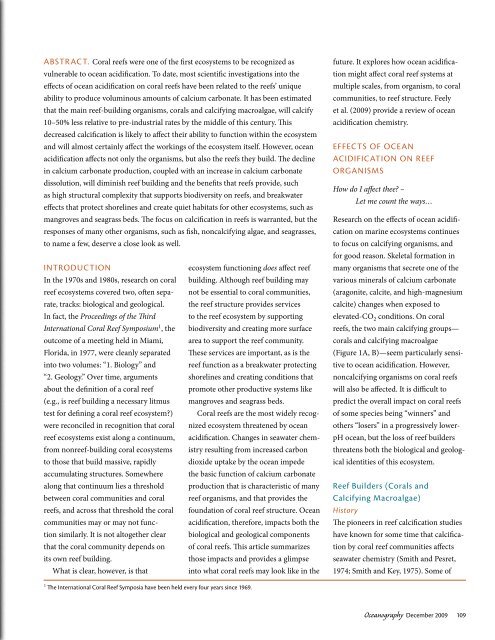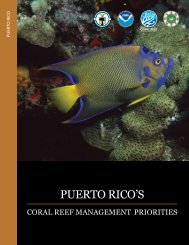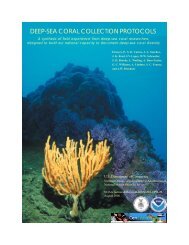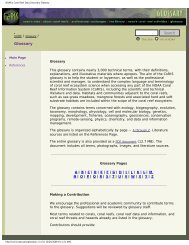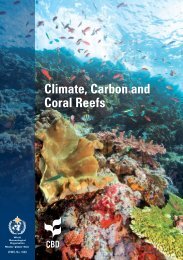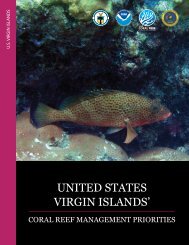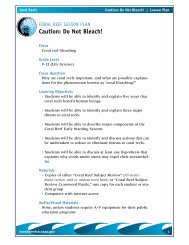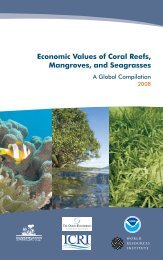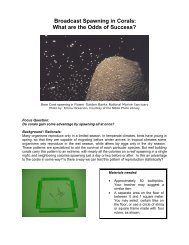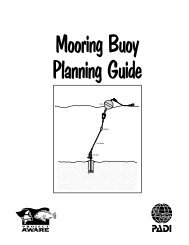coral reefs and Ocean acidification
coral reefs and Ocean acidification
coral reefs and Ocean acidification
You also want an ePaper? Increase the reach of your titles
YUMPU automatically turns print PDFs into web optimized ePapers that Google loves.
aBStract. Coral <strong>reefs</strong> were one of the first ecosystems to be recognized as<br />
vulnerable to ocean <strong>acidification</strong>. To date, most scientific investigations into the<br />
effects of ocean <strong>acidification</strong> on <strong>coral</strong> <strong>reefs</strong> have been related to the <strong>reefs</strong>’ unique<br />
ability to produce voluminous amounts of calcium carbonate. It has been estimated<br />
that the main reef-building organisms, <strong>coral</strong>s <strong>and</strong> calcifying macroalgae, will calcify<br />
10–50% less relative to pre-industrial rates by the middle of this century. This<br />
decreased calcification is likely to affect their ability to function within the ecosystem<br />
<strong>and</strong> will almost certainly affect the workings of the ecosystem itself. However, ocean<br />
<strong>acidification</strong> affects not only the organisms, but also the <strong>reefs</strong> they build. The decline<br />
in calcium carbonate production, coupled with an increase in calcium carbonate<br />
dissolution, will diminish reef building <strong>and</strong> the benefits that <strong>reefs</strong> provide, such<br />
as high structural complexity that supports biodiversity on <strong>reefs</strong>, <strong>and</strong> breakwater<br />
effects that protect shorelines <strong>and</strong> create quiet habitats for other ecosystems, such as<br />
mangroves <strong>and</strong> seagrass beds. The focus on calcification in <strong>reefs</strong> is warranted, but the<br />
responses of many other organisms, such as fish, noncalcifying algae, <strong>and</strong> seagrasses,<br />
to name a few, deserve a close look as well.<br />
iNtrOductiON<br />
In the 1970s <strong>and</strong> 1980s, research on <strong>coral</strong><br />
reef ecosystems covered two, often separate,<br />
tracks: biological <strong>and</strong> geological.<br />
In fact, the Proceedings of the Third<br />
International Coral Reef Symposium1 , the<br />
outcome of a meeting held in Miami,<br />
Florida, in 1977, were cleanly separated<br />
into two volumes: “1. Biology” <strong>and</strong><br />
“2. Geology.” Over time, arguments<br />
about the definition of a <strong>coral</strong> reef<br />
(e.g., is reef building a necessary litmus<br />
test for defining a <strong>coral</strong> reef ecosystem?)<br />
were reconciled in recognition that <strong>coral</strong><br />
reef ecosystems exist along a continuum,<br />
from nonreef-building <strong>coral</strong> ecosystems<br />
to those that build massive, rapidly<br />
accumulating structures. Somewhere<br />
along that continuum lies a threshold<br />
between <strong>coral</strong> communities <strong>and</strong> <strong>coral</strong><br />
<strong>reefs</strong>, <strong>and</strong> across that threshold the <strong>coral</strong><br />
communities may or may not function<br />
similarly. It is not altogether clear<br />
that the <strong>coral</strong> community depends on<br />
its own reef building.<br />
What is clear, however, is that<br />
ecosystem functioning does affect reef<br />
1 The international <strong>coral</strong> reef Symposia have been held every four years since 1969.<br />
building. Although reef building may<br />
not be essential to <strong>coral</strong> communities,<br />
the reef structure provides services<br />
to the reef ecosystem by supporting<br />
biodiversity <strong>and</strong> creating more surface<br />
area to support the reef community.<br />
These services are important, as is the<br />
reef function as a breakwater protecting<br />
shorelines <strong>and</strong> creating conditions that<br />
promote other productive systems like<br />
mangroves <strong>and</strong> seagrass beds.<br />
Coral <strong>reefs</strong> are the most widely recognized<br />
ecosystem threatened by ocean<br />
<strong>acidification</strong>. Changes in seawater chemistry<br />
resulting from increased carbon<br />
dioxide uptake by the ocean impede<br />
the basic function of calcium carbonate<br />
production that is characteristic of many<br />
reef organisms, <strong>and</strong> that provides the<br />
foundation of <strong>coral</strong> reef structure. <strong>Ocean</strong><br />
<strong>acidification</strong>, therefore, impacts both the<br />
biological <strong>and</strong> geological components<br />
of <strong>coral</strong> <strong>reefs</strong>. This article summarizes<br />
those impacts <strong>and</strong> provides a glimpse<br />
into what <strong>coral</strong> <strong>reefs</strong> may look like in the<br />
future. It explores how ocean <strong>acidification</strong><br />
might affect <strong>coral</strong> reef systems at<br />
multiple scales, from organism, to <strong>coral</strong><br />
communities, to reef structure. Feely<br />
et al. (2009) provide a review of ocean<br />
<strong>acidification</strong> chemistry.<br />
eFFectS OF OceaN<br />
acidiFicatiON ON reeF<br />
OrgaNiSmS<br />
How do I affect thee? –<br />
Let me count the ways…<br />
Research on the effects of ocean <strong>acidification</strong><br />
on marine ecosystems continues<br />
to focus on calcifying organisms, <strong>and</strong><br />
for good reason. Skeletal formation in<br />
many organisms that secrete one of the<br />
various minerals of calcium carbonate<br />
(aragonite, calcite, <strong>and</strong> high-magnesium<br />
calcite) changes when exposed to<br />
elevated-CO2 conditions. On <strong>coral</strong><br />
<strong>reefs</strong>, the two main calcifying groups—<br />
<strong>coral</strong>s <strong>and</strong> calcifying macroalgae<br />
(Figure 1A, B)—seem particularly sensitive<br />
to ocean <strong>acidification</strong>. However,<br />
noncalcifying organisms on <strong>coral</strong> <strong>reefs</strong><br />
will also be affected. It is difficult to<br />
predict the overall impact on <strong>coral</strong> <strong>reefs</strong><br />
of some species being “winners” <strong>and</strong><br />
others “losers” in a progressively lowerpH<br />
ocean, but the loss of reef builders<br />
threatens both the biological <strong>and</strong> geological<br />
identities of this ecosystem.<br />
reef Builders (<strong>coral</strong>s <strong>and</strong><br />
calcifying macroalgae)<br />
History<br />
The pioneers in reef calcification studies<br />
have known for some time that calcification<br />
by <strong>coral</strong> reef communities affects<br />
seawater chemistry (Smith <strong>and</strong> Pesret,<br />
1974; Smith <strong>and</strong> Key, 1975). Some of<br />
<strong>Ocean</strong>ography december 2009 109


